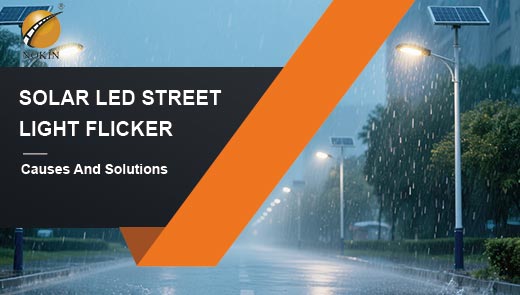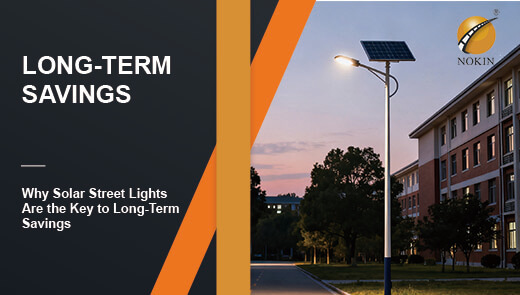How Wattage and Lumens Affect Solar Street Lighting Efficiency
In the past, solar street lights were difficult to meet the lighting needs of public areas and roads due to factors such as insufficient brightness and unstable battery life. However, today, with the rapid development of solar technology, the power generation efficiency of solar panels, LED technology and battery storage technology, solar street lights have transformed into stable, efficient and long-lasting lighting solutions.
When evaluating the performance of solar street lights, wattage and lumens are two core indicators. They not only determine the brightness and energy consumption of street lights, but also directly affect the efficiency and battery life of solar energy systems. This article will deeply analyze the relationship between these two indicators and how they work together to shape the performance of solar street lights.
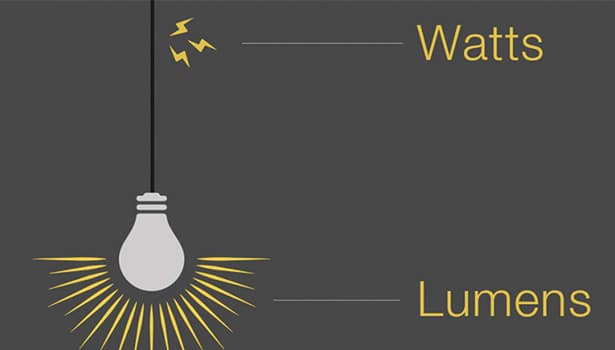
Difference and Connection between Lumens and Wattage
To understand the efficiency of solar street lights, we first need to clarify the definition and difference between lumens and wattage. These two indicators seem simple, but they carry the most core performance information of the lighting system.
Lumens
Lumens is a unit for measuring the total amount of visible light emitted by a light source. Simply put, the higher the lumen value, the brighter the light emitted by the light source. For solar street lights, lumens directly determine the lighting effect - whether it is road visibility, pedestrian safety, or vehicle driving safety, they are all closely related to the lumen value.
For example, a rural road may only need 300-600 lumens of lighting to meet pedestrian needs, while a main road requires 3000-6000 lumens to ensure that drivers can clearly identify road conditions at night.
Watts
Watts is a unit of measurement of the rate at which a light source consumes energy. The higher the value, the more electrical energy the light source consumes per unit time. In the era of traditional lighting, people often equate high wattage with high brightness, but this perception is no longer applicable in the LED era.
In traditional incandescent lamps, most of the energy is converted into heat rather than light, so the wattage must be increased to achieve high brightness. LED lamps can directly convert more energy into visible light, which breaks the inherent logic of "high wattage = high brightness".
Lumens vs. Wattage: Luminous Efficacy
The ratio of lumens to wattage, or the number of lumens per watt of electrical energy (lm/W), is called luminous efficiency. This metric is the core standard for measuring the efficiency of a lighting system - the higher the value, the more light the light source can produce while consuming the same amount of energy, and the higher the efficiency.
The luminous efficiency of different types of lamps varies significantly:
- Incandescent lamps: The luminous efficiency is extremely low, only 10-17 lm/W. For example, a 60-watt incandescent lamp produces about 800 lumens and has an efficiency of only 13.34 lm/W.
- CFL (compact fluorescent lamp): The efficiency has improved to about 53.34 lm/W. A 15-watt CFL can produce 800 lumens and consume only a quarter of the energy of an incandescent lamp.
- LED lamps: The efficiency is far higher than traditional lamps. In 2009, 80 lm/W LEDs were considered efficient, but by 2024, advanced LED technologies such as Philips LUXEON 3030 2D mid-power LEDs have reached 209 lm/W, more than 12 times that of incandescent lamps.
For solar street lights, luminous efficiency directly determines their endurance and reliability. Under the same solar panel and battery configuration, street lights with higher luminous efficiency can maintain lighting for longer on rainy days or when there is insufficient light.
How Wattage and Lumen Affect Solar Street Light Efficiency
The efficiency of solar street lights is not determined by a single indicator, but the result of the combined effect of wattage and lumen. Understanding the balance between the two is the key to choosing efficient solar street lights.
Balancing Energy Consumption and Brightness
The energy of solar street lights comes from limited solar energy storage, so it is necessary to find the best balance between "energy consumption" and "brightness".
Inefficient scenarios:
Street lights with high wattage but low lumens are typical representatives of inefficiency. This type of solar street light consumes a lot of energy when running, but cannot provide enough brightness, resulting in early light off at night and inability to provide long-term lighting.
High efficiency scenario:
Low-wattage but high-lumen solar street lights are ideal. It can reduce energy consumption while ensuring brightness, which not only extends battery life but also meets lighting needs.
For example, two solar street lights provide 5,000 lumens at the same time: one requires 50 watts of power and the other only requires 25 watts of power. Obviously, the 25-watt street light is more efficient because it consumes less energy at the same brightness and can maintain twice the lighting time on cloudy days.
Specific Impact on Solar Energy Systems
The values of wattage and lumen directly affect the design and performance of solar street light systems:
- Advantages of low wattage: Reduce energy consumption per unit time, which means that the battery can store less energy to meet nighttime lighting needs, while reducing the power requirements of solar panels and reducing the overall cost of the system.
- The value of high lumens: Ensure that the lighting effect meets the standards. Whether it is basic safety lighting for pedestrians or high visibility requirements for main roads, sufficient lumen output is a prerequisite.
In actual applications, the design of solar street lights needs to reversely calculate the reasonable ratio of wattage and lumen according to the lighting conditions and lighting duration requirements of the installation scene. For example, in areas with sufficient light, the wattage can be appropriately increased in exchange for higher brightness; in areas with weak light, it is necessary to prioritize high luminous efficiency to avoid insufficient battery life.
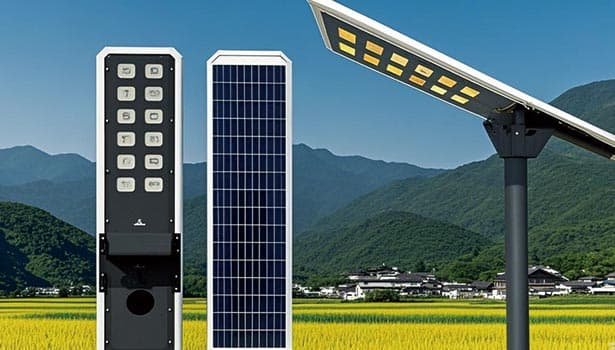
Wattage and Lumen Selection Guide for Different Scenarios
The core value of solar street lights lies in "on-demand lighting" - neither wasting energy nor sacrificing safety. The functional positioning, flow of people, and activity types of different scenarios directly determine the demand for wattage (energy consumption) and lumen (brightness). The following is a breakdown of the parameter selection logic of each scenario based on actual applications.
Sidewalks, Community Trails
Scenario characteristics: mainly pedestrians walking, the lighting purpose is to "identify road obstacles" (such as steps, potholes) and "basic safety warnings" (such as the presence of others), without strong light.
Brightness requirements: It allows pedestrians to see the details of the road within 3-5 meters and avoid bumps.
Recommended parameters:
- Wattage: 10-20W (low energy consumption, reducing battery burden)
- Lumen: 1500-3000LM (reference 150LM/W efficiency, 10W corresponds to 1500LM, 20W corresponds to 3000LM)
Selection logic:
- Too high brightness will cause glare (such as directly shining into pedestrians' eyes), which will affect comfort;
- Late at night when there are fewer people, intelligent dimming (such as reducing brightness to 50%) can be used to further save energy.
Parks, Squares, Secondary Branches
Scene features: Pedestrians walking, leisure activities (such as square dancing, children playing) and low-speed vehicles (electric vehicles, bicycles) passing through, need to cover a larger range, and ensure "activity visibility" (such as seeing faces and object outlines clearly).
Brightness requirements: Make activities within 10-15 meters clearly visible, while covering an area of 100-300㎡.
Recommended parameters:
- Wattage: 20-40W (balance coverage and energy consumption)
- Lumen: 3000-6000LM (20W corresponds to 3000LM, 40W corresponds to 6000LM, based on 150LM/W efficiency)
Selection logic:
- When there are many trees in the park, the lumen needs to be slightly increased (such as 40W/6000LM) to avoid the formation of dark areas under the shade of the trees;
- The wattage can be appropriately reduced in open areas such as squares (such as 25W/3750LM) and covered by evenly arranged lights (spacing 8-10 meters).
Urban Secondary Roads, Small Parking Lots
Scene characteristics: There are motor vehicles passing (speed ≤40km/h), vehicles parking or short-term stops, and the "vehicle identification distance" (such as seeing pedestrians and obstacles within 50 meters) and "spatial positioning" (such as parking lot parking lines) need to be guaranteed.
Brightness requirement: The light needs to cover a road width of 5-8 meters to ensure that drivers can quickly respond to emergencies at night.
Recommended parameters:
- Wattage: 40-80W (meeting medium range coverage)
- Lumen: 6000-12000LM (40W corresponds to 6000LM, 80W corresponds to 12000LM, based on 150LM/W efficiency)
Selection logic:
- If there are buildings on both sides of the secondary road blocking the light, it needs to be increased to 60-80W (9000-12000LM) to avoid uneven light and dark on the road;
- Small parking lots (within 20 parking spaces) can choose 40-50W (6000-7500LM), and install at a density of "1 lamp per 2 parking spaces", taking into account both brightness and energy saving.
Main Roads, Large Logistics parks
Scene characteristics: high-speed motor vehicle traffic (speed ≥ 50km/h), frequent activities of large vehicles (such as trucks, forklifts), need to ensure "long-distance recognition" (such as seeing road conditions, traffic signs, pedestrians within 100 meters) and "large area coverage" (road width 8-15 meters).
Brightness requirements: light needs to penetrate night fog and have high uniformity (no obvious light spots or dark areas) to avoid driver visual fatigue.
Recommended parameters:
- Wattage: 80-150W (high power supports wide coverage)
- Lumen: 12000-22500LM (80W corresponds to 12000LM, 150W corresponds to 22500LM, based on 150LM/W efficiency)
Selection logic:
- The main roads need to strictly control the "uniformity of illumination", and 100-150W (15000-22500LM) is recommended, with an installation spacing of 25-30 meters to ensure continuous lighting of the road surface;
- Large logistics parks need to focus on covering the loading and unloading areas due to frequent vehicle loading and unloading. 120-150W (18000-22500LM) can be used locally, with 60-80W auxiliary lighting in the surrounding area to avoid energy waste.
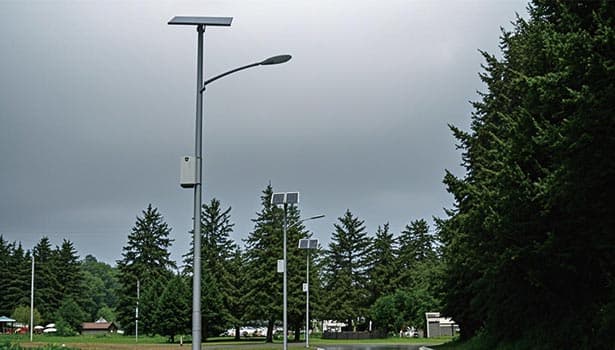
Special Scenarios
Remote rural roads:
Features: There are very few people and vehicles, and only "night outline" (marking road boundaries) is required, and high brightness is not required.
Recommended: 10-15W, 1500-2250LM (reduce costs and extend battery life on rainy days).
Highway service area:
Features: large traffic volume and frequent nighttime activities, requiring "full-area lighting without dead angles".
Recommended: 150-200W, 22500-30000LM (high brightness covers refueling area, parking area, and passage).
Scenic area landscape lighting:
Features: need to take into account both "lighting" and "atmosphere" to avoid strong light destroying the night view.
Recommended: 20-30W (3000-4500LM), with warm light color temperature and soft light lens, balance brightness and beauty.
In short, the core of parameter selection is not "the higher the better", but "just meet the needs" - let every bit of energy consumption be converted into the necessary brightness, which is the ultimate embodiment of the efficiency of solar street lights.
How LED Technology Optimizes the Balance between Wattage and Lumen
The emergence of LED technology has completely changed the development trajectory of solar street lights. It makes "low wattage and high brightness" possible by greatly improving the luminous efficiency, laying the core foundation for the popularization of solar lighting.
Revolutionary Breakthrough in LED Technology
Compared with traditional incandescent lamps and CFL lamps, LED has irreplaceable advantages in energy conversion efficiency:
- Short energy conversion path: LED directly converts electrical energy into visible light, with very little heat waste;
- Luminous efficiency jumps: from 80 lm/W in 2009 to 209 lm/W in 2024 (such as Philips LUXEON 3030 LED), the efficiency has increased by nearly 3 times;
- Strong controllability: LED can adjust the brightness through smart chips to achieve "on-demand lighting" and further optimize energy consumption.
For solar street lights, the low wattage characteristics of LEDs mean lower energy requirements, which directly reduces the requirements for solar panels and battery capacity, not only reducing the initial investment, but also improving the reliability of the system under low light conditions.
The Actual Value of LED Technology to Users
Choosing LED solar street lights can bring users multi-dimensional benefits:
- Long-term energy saving: Under the same lighting effect, the energy consumption of LED is only 1/10 of that of incandescent lamps and 1/3 of that of CFL lamps, which greatly reduces the load of the solar energy system;
- Reduced maintenance costs: The service life of LED can reach 50,000-100,000 hours, which is more than 50 times that of incandescent lamps, reducing the manpower and material costs of frequent replacement of lamps;
- Enhanced environmental protection attributes: Low energy consumption means less frequent battery replacement, reducing the pollution risk of waste batteries, which is highly consistent with the green concept of solar energy.
For users such as municipal departments and property managers, although the initial investment of LED solar street lights is higher than that of traditional street lights, combined with the advantages of more than 10 years of service life and zero electricity bills, the comprehensive cost is lower. Especially in remote areas, the saved cable laying costs are enough to cover the initial price difference.
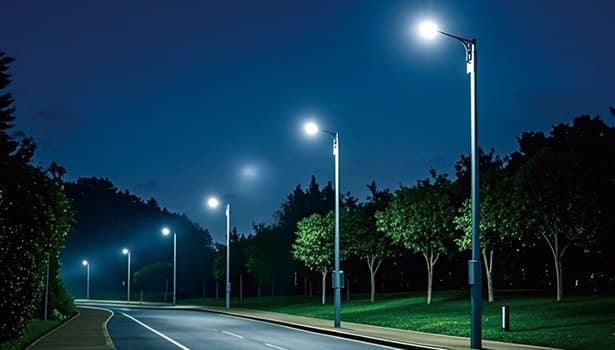
Conclusion
The efficiency of solar street lights is not determined by a single indicator of wattage or lumen, but the "balance art" of the two. High lumen ensures lighting effect, low wattage controls energy consumption, and luminous efficiency (lm/W) is the ultimate standard for measuring this balance.
When choosing solar street lights, keep the following principles in mind:
Give priority to luminous efficiency: Under the same conditions, 200 lm/W products are definitely better than 150 lm/W products;
Match scene requirements: Determine a reasonable wattage and lumen range based on the purpose, area, and lighting conditions of the lighting area;
Choose LED technology: LED is the only mature solution to achieve "high brightness and low energy consumption", avoiding solar products with traditional light sources.
With the continuous advancement of technology, the luminous efficiency of solar street lights will be further improved, and in the future it may be possible to achieve a breakthrough of "300 lm/W" or even higher. However, no matter how the technology develops, the core logic of "matching wattage and lumen on demand" will not change - only by converting every kilowatt-hour of electricity into the most needed light can the high efficiency value of solar street lights be truly brought into play.


